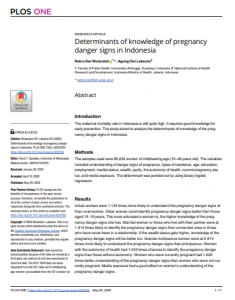
Introduction
The maternal mortality rate in Indonesia is still quite high. It requires good knowledge for early prevention. The study aimed to analyze the determinants of knowledge of the pregnancy danger signs in Indonesia.
Methods
The samples used were 85,832 women of childbearing age (15–49 years old). The variables included understanding of danger signs of pregnancy, types of residence, age, education, employment, marital status, wealth, parity, the autonomy of health, current pregnancy status, and media exposure. The determinant was pointed out by using binary logistic regression.
Results
Urban women were 1.124 times more likely to understand the pregnancy danger signs of than rural women. Older women could identify pregnancy danger signs better than those aged 15–19 years. The more educated a woman is, the higher knowledge of the pregnancy danger signs she has. Married women or those who live with their partner were at 1.914 times likely to identify the pregnancy danger signs than unmarried ones or those who have never been in a relationship. If the wealth status gets higher, knowledge of the pregnancy danger signs will be better too. Grande multiparous women were at 0.815 times more likely to understand the pregnancy danger signs than primiparous. Women with the autonomy of health had 1.053 times chances to identify the pregnancy danger signs than those without autonomy. Women who were currently pregnant had 1.229 times better understanding of the pregnancy danger signs than women who were not currently pregnant. Media exposure had a good effect on women’s understanding of the pregnancy danger signs.